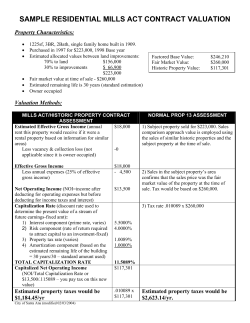
Handout
IMPORTANT DEFINITIONS Annual Debt Service (ADS): The total amount of principal and interest to be paid each year to satisfy the obligations of a loan contract. Capitalization Rate (Cap): A percentage that relates the value of an income producing property to its future income. NOI/Purchase Price = Cap Cash flow (CF): The periodic amounts of money received by an investor from operations of the real estate investment after all expenditures. (CFBT) cash flow before taxes and (CFAT) cash flow after taxes Cash on Cash Rate (COC): A quick and simple investment return measure. Calculated as cash flow before taxes divided by initial equity investment. Debt Coverage Ratio (DCR): The ratio of net operating income to annual debt service. NOI /ADS = DCR Discount Rate: The interest rate that is used to convert between future values and present values. Note that the process of calculating present values is often referred to as “discounting” because present values are generally less than future values. Economic Occupancy: The amount of rent that is collected from Residents/Tenants compared to the amount that actually could be collected. (Gross Rent-VacancyConcessions-loss to lease + gain to lease) Effective Rate: The average rental rate over the term of the lease after factoring in free rent or other monetary concessions granted to the Resident/Tenant Future Value (FV): Refers to a method of calculating how much the present value (PV) of an asset or cash will be worth at a specific time in the future.” Literally translated, future value means “what will it be worth at some future point in time?” Hold Period: The anticipated length of time an investor intends to hold an asset. It is dependent upon investment parameters, preferences, market factors, anticipated strategy for the asset (turn around property vs. long term hold) Can and does sometimes change due to unforeseen factors. Interest Rate (r): A Lender’s rate of return on borrowed funds. Internal Rate of Return (IRR): The percentage rate earned on each dollar that remains in an investment each year. The IRR of an investment is the discount rate at which the sum of the present value of future cash flows equals the initial investment. Market Value: The most probable price that a property would bring in a competitive and open market under “fair sale” conditions. Net Operating Income (NOI): The potential rental income plus other income, less vacancy, credit losses and operating expenses (before deducting capital costs, reserves or Taxes other than RE Taxes). Net Present Value (NPV): is the present value of the investments expected cash flows, LESS the initial cost of the investment. It is a direct measure of “cost vs benefit”. It represents the economic profit to be earned by making an investment. Payback: The amount of time (calculated in months or years) it takes to recoup the investment through realized profits or savings. Investment / profits = payback Present Value (PV): The sum of all future cash flows accruing to the owner of an asset they are discounted to the present by an appropriate discount rate. In other words, it is the amount that you would be willing to pay today in order to receive a cash flow (or a series of them) in the future. Literally translated, present value means “what is it worth right now?” Proforma: The projection of income, expenses, NOI and Cash Flows that a lender or investor anticipates based upon their investment strategy and assumptions. Replacement Cost: The cost to build a similar property in a similar location. Return on Investment (ROI): The percentage return on each dollar invested. Also known as yield. Reversion: The estimated value of an asset when it is sold at the end of the investment holding period. Usually estimated by using the NOI from the year subsequent to the last year of the projected cash flow analysis divided by a cap rate. Stabilized Proforma: Same as a Proforma but based on assumptions of when the asset reaches stability in occupancy. Time Value of Money (TVM): An economic principle recognizing that because of earning power, a dollar today has a greater value than a dollar tomorrow. The concept underlies much of financial mathematics Yield: A measure of investment performance gauging the percentage return on each dollar invested. Also known as the rate of return.
© Copyright 2025



















